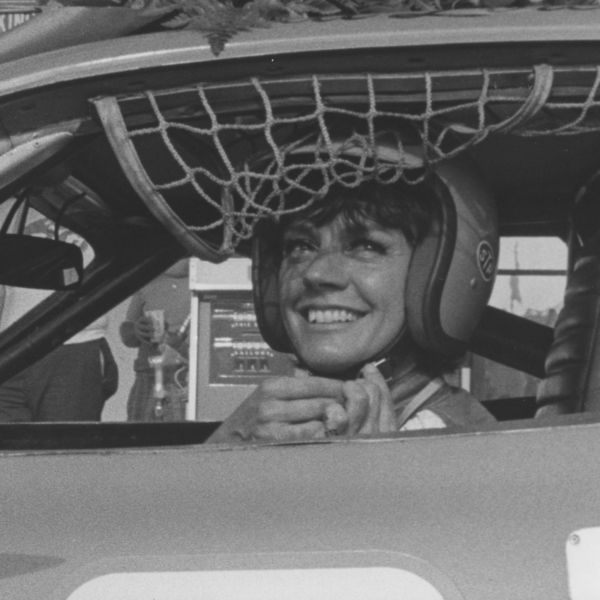
First woman to drive a jet dragster
First woman licensed to drive a nitromethane-fueled car
One of the first women to obtain an NHRA license
Set a women’s closed-course record at Talladega Superspeedway
One of the top Funny Car match racers of ‘60s/early ‘70s
Set multiple women’s land speed records at Bonneville
Motorsports Series:
AHRA, IHRA & NHRA
While she never achieved the level of prominence and acceptance enjoyed by Hall of Famer Shirley Muldowney, Paula still played a pivotal role in drag racing's formative years. She was the first woman licensed to drive a supercharged fuel car and was a seasoned veteran when she received her NHRA license. She was a successful match racer, driving an STP-sponsored Funny Car in an era when few drivers had sponsorship of any kind. In 1963 she set a 161 mph women's speed record at Bonneville and later boosted her woman's land speed record to 236.37 mph in Walt Arfons' jet car. In the quarter-mile, she broke the 200 mph barrier and won the Olympics of Drag Racing and remained strong in Funny Car competition through the end of 1972, when a ride in a rocket-powered machine at Bonneville prompted her to switch to rocket dragsters. On her first full pass at Sears Point Raceway, the engine failed at 300 plus mph, causing a crash that ended her promising career.
By Jon Asher
At a time when some racing organizations feel the need to tout their efforts towards gender and ethnic diversity, it’s somewhat ironic that drag racing has been all about such things since the beginning. Case in point: 2017 inductee Paula Murphy, who was racing successfully on asphalt and salt decades before anyone even mentioned diversity. When Murphy began match racing with a Funny Car (she was the first woman licensed to drive a nitromethane-fueled car), her appearance wasn’t always met with a hearty smile and a handshake. In an endeavor that was “owned” by men, a loss to Ms. Murphy could result in ribbing from one’s peers that some men never got over.
What made the losing all the more difficult was the mischievous smile that rarely left Murphy’s face. She never traded barbs with the guys. She let her Miss STP Plymouth do the talking, and woe be unto those who lost their tempers. Murphy’s mechanic, ”Fat Jack” Bynum, was the size of a small building and liked nothing better than “discussing things” with anyone who dissed his driver.
Like many other Hall of Fame inductees, Murphy was a multifaceted competitor. She set records on the Bonneville Salt Flats and won sports car races, all at a time when the sight of a woman pulling on a helmet was enough to give some men apoplexy. And, just as she would in drag racing, Murphy just unfurled that killer smile and kept winning.
Murphy had a long relationship with STP thanks to a decades-long friendship between her and 2001 inductee Andy Granatelli. In the late ‘60s, when match racing was king, someone at the NHRA decided to rescind the licenses that had already been granted to several women, including Murphy. Despite howls of protest from the fans, the NHRA was intransigent until Granatelli interceded. The fact that STP was a major sponsor gave his words added weight, and the ban was lifted.
Murphy wasn’t a regular in NHRA competition, preferring AHRA and IHRA events, where she’d receive considerable appearance money. She deserved it. One only had to see the long lines of fans clamoring for her autograph to understand her drawing power.
Proving that she could drive anything, STP arranged for her to make a few laps at Talladega in Fred Lorenzen’s Dodge in the early ‘70s. She set a women’s closed-course record that stood for years. But life ultimately proved that Ms. Murphy couldn’t drive “anything.” She made a few runs in Tony Fox’s hydrogen peroxide-powered rocket car in 1973, and was slated to tour in ’74 with Ky Michaelson’s similar machine. During an early outing at Sears Point the rocket engine refused to shut down, both parachutes ripped off, and the car cartwheeled past the finish line. Murphy suffered a broken neck, lucky to escape with her life. She finished her career drag racing factory-prepared Datsuns and Hondas.
Murphy helped open the door for other women. Along with the exceptional skills she regularly demonstrated was her overwhelmingly likable personality. She may not have been a world champion, but Paula Murphy was first. And one of the best.
Jon Asher is Senior Editor for CompetitionPlus.com and Drag Racing Edge Magazine. This is his 51st year of writing about and photographing drag racing. He’s received two Special Recognition Awards from the All-Star Drag Racing Team, the Founders Award from the International Drag Racing Hall of Fame and AARWBA’s Straight Shooters Award.